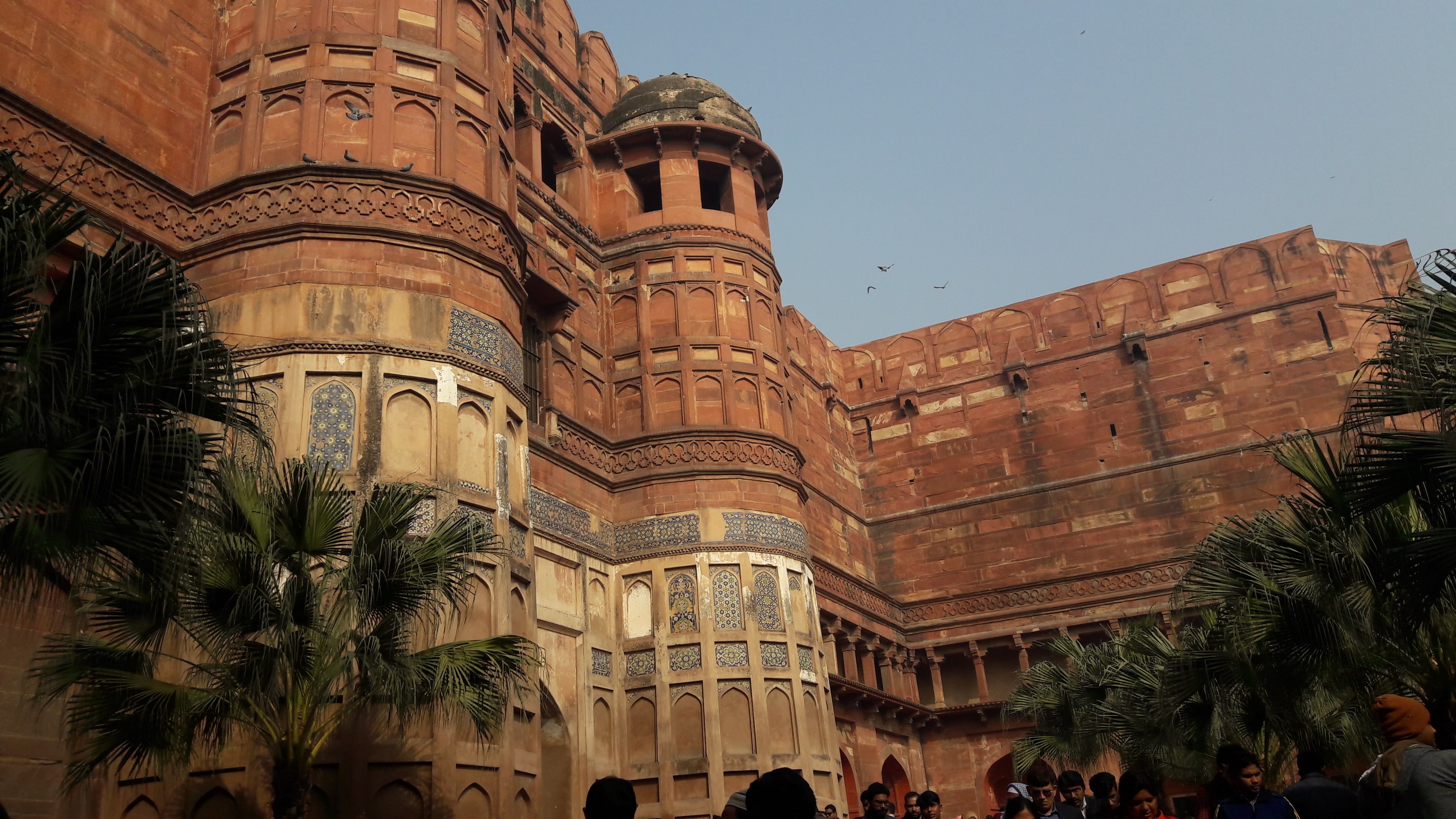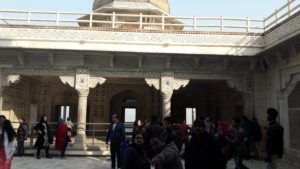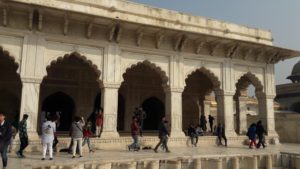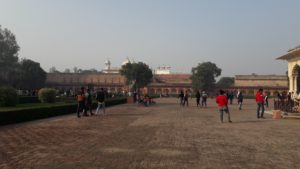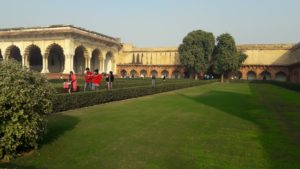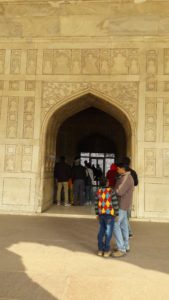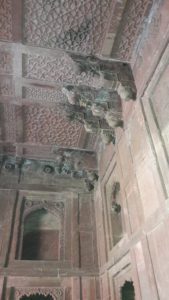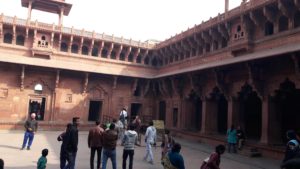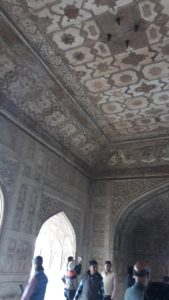Weekend Trip to Agra Fort
Taj Mahal and Agra Fort are located in the ancient city of Agra in UttarPradesh, India. With the construction of Taj Express way, it has become an easy drive from Delhi. Situated at a distance of about 230 kms from Delhi, it takes about 3 hrs to reach Agra
Taking advantage of a long weekend, we left Delhi at around 7.00 AM for Agra for an overnight trip. En route we stopped at eatery joints all built in a huge complex – there are variety of o ptions such as Indian food at Bikano, Pizza at Dominoes, Indian food at Dhabha, continental at Starbucks or Subway. We took an hour break and then embarked on the journey again. The road is fantastic and it really gives a thrill to hit the paddle at 130 km/hr.

Lobby of Radison Blu, Agra
We reached Agra, Radisson Blu at around 1.00 PM and quickly checked into our rooms. There are lot of stay options available in this tourist centric city – there are homestays, hotels as well as UP tourism guest house.
Taj entrance is just walkable distance from the hotel (about 1.4 Kms). We decided to walk down the road, although there are other options such as auto rikshaw, pedicabs and good old horse cart or Tonga.
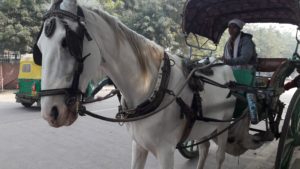
Tonga – a joy ride in Agra
Tonga is a very old way of transportation – used since time immemorial but very few places in India now offers this mode of transportation. Agra, Hyderabad, Amritsar are few of the old cities which offer this opportunity to experience riding a horse cart.
The entire stretch of 1.4 km is laid in red sandstone is so very typical of Agra and there are shops all along the way upto the ticket counter. Shops sell marble souvenirs, leather chappals or footwear, typical local embroidered kurtis – in a nutshell lot of things you can pick up from. The city is also famous for petha, an indian delicacy, a must try for the sweet tooth.
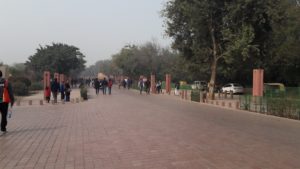
Heritage walk leading to Taj Mahal
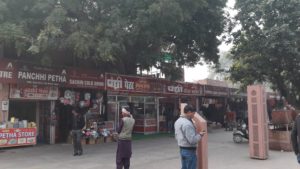
Shops selling souvenirs all along the stretch to Taj Mahal
You need to purchase tickets in order to see Taj and to our dismay there was a huge que – it seemed the entire NCR had gathered. It took us good half an hour to procure the tickets and we were happy that now we can see Taj. But the happiness was short lived. To our dismay, there was a big que at the entrance again where security check was taking place. We stepped out of the que and checked with officials and they said it will take about 4 hrs for our turn to come and suggested that best is to come next day early morning as there will be no que. (So, two learnings – one book tickets online so you will save time in booking tickets. Two, reach Taj entrance by 8 AM to avoid que).
We took a call that rather than wasting time standing in the que, we should visit Agra Fort and so we decided to take an autorickshaw to Agra Fort. Connectivity is no issue in this ancient city as tourism is the main industry here. We reached Agra Fort in 20 minutes at around 2 PM.
There are lot of guides available here and it is highly recommended to take a guide who can explain you all the stories and intricacies. We took tickets for entering the Fort and hired a guide and then began the tour into the Indian Mughal history.

Entrace for tourists, Agra Fort, Picture Credit – Wikipedia
Built in 1573, it took more than 4000 workers and eight years to complete the Agra fort. The fort remained as the main residence of the emperors belonging to the Mughal dynasty until the year 1638.
The fort houses numerous impressive structures like the Jahangir Mahal, Khas Mahal, Diwan-i-Khass, Diwan-i-Am, Machchhi Bhawan and Moti Masjid. The fort is situated at a distance of about 2.5 kilometers from Taj Mahal.
In 1638, the Mughals moved their capital from Agra to Delhi, causing the Agra Fort to lose its status as the main residence of the Mughal emperors. Often described as the walled city, Agra Fort is a UNESCO World Heritage site. Today, the fort is a major tourist spot and attracts many tourists from all over the world.
History of the Fort (as sourced from Wikipedia, culturalIndia and as verified by the guide)
Agra Fort is known for its rich history. The fort has been owned by many emperors and rulers in the past, undergoing many changes in its appearance.
It all began in the year 1526 when the first battle of Panipat was fought between Babur and Ibrahim Lodi of the Lodi dynasty. When Babur defeated Ibrahim Lodi, he made the fort as his home. He then modified the fort . Babur’s successor, Humayun’s coronation took place at the fort in the year 1530.
In 1540, Sher Shah Suri of the Sur Empire waged a war against Humayun and defeated him at Bilgram. Sher Shah Suri took over the ownership of the fort from Humayun and made minor changes to it, so as to suit his own architectural taste. The fort stayed with the emperors of the Sur dynasty for the next 15 years. In 1555, Humayun managed to recapture Agra and with it the fort as well. But a year later, Hemu, the general and military commander of Adil Shah Suri (final emperor of the Sur dynasty) captured Agra and declared himself as king. Barely a month into the kingship of Hemu, Akbar, along with his army, marched into Delhi and defeated the forces of Hemu. The fort once again belonged to the Mughals, but was fast disintegrating. Back then, it was known as Badalgarh and was built with bricks alone. Realizing its historical and situational significance, Akbar decided to rebuild it with red sandstone.
During the reign of Shah Jahan, the fort was modified considerably and took the current form. Shah Jahan destroyed some of the edifices within the fort and rebuilt it as per his own architectural taste. During the early 17th century, the fort was captured by the Maratha Empire.During this period, the fort saw many owners including various Maratha emperors and their enemies which included a host of Mughal emperors. In 1761, the Marathas underwent a massive defeat at the hands of Ahmad Shah Durrani, founder of the Durrani Empire. The emperors of the Durrani dynasty made the fort their home until 1785. In 1785, the fort was regained by the Marathas under the reign of Mahadji Shinde. The Marathas then lost their battle against the British in the Second Anglo-Maratha War and with it the fort. The British then enjoyed the comfort of the fort until it was handed over to the government of India in 1947.
Layout and Architecture:
The 380,000-square-metre (94-acre or a stretch of 2.5 km ) fort has a semicircular plan, its chord lies parallel to the river and its walls are seventy feet high. The walls of the fort are a massive seventy feet high. The fort, when viewed from above, has a semicircular shape. The base of the fort faces the bank of the river Yamuna.
It has four gates (one on each side). Out of the four gates, the Delhi gate and Lahore gate are the most prominent ones. The Lahore gate was later renamed as Amar Singh Gate. Akbar used the Delhi gate as his main entrance and the gate also served as a security against the invaders. There is also an inner gateway known as the Elephant Gate.
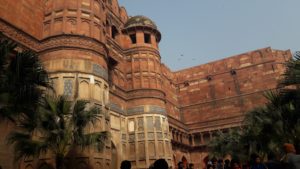
Akbar Darwaza
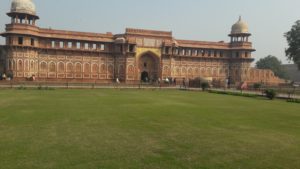
Jahangir Palace
The entrances were built in a Z pattern to ensure that the invaders found it difficult to enter the fort even with the help of war elephants. Because the Indian military is still using the northern portion of the Agra Fort, the Delhi Gate cannot be used by the public. Tourists enter via the Amar Singh Gate.
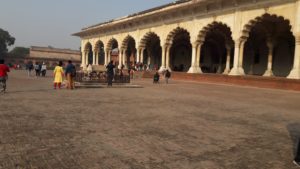
Vast courtyard in front of Diwan-i-aam
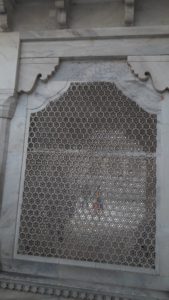
Jalidar nakkashi – a typical feature of mughal architecture inside the fort
The fort has various palaces and halls. The Amar Singh gate leads to the courtyard. The magnificent Diwan-I-Am (Hall of Public Audience) is on the right hand side. Among the palaces, the prominent ones is Shah Jahani Mahal. A little further lay the royal pavilions, which houses the famous Nagina Masjid and Mina Masjid. The fort also has royal baths made out of marbles, which were used by the princesses. Also, places of worship and a private market place for the ladies were built within the fort.
At the base of the fort, a secret passage was dug in an attempt to access it with ease, during times of emergency. Other attractions of the fort include a grape garden, a jasmine tower, a mirror palace (Shish Mahal), courtrooms and the ruins of Akbar’s once magnificent palace. It is said that the fort once housed five hundred beautiful looking buildings. Unfortunately, many of those buildings were destroyed at different time periods for various reasons.
Bricks formed the base of Agra Fort’s structure. Red sandstone was brought all the way from Rajasthan and that was laid on the external surfaces. Back then, the entire fort was built using the red sandstone. This appearance of the fort underwent a major change during the reign of Shah Jahan. Unlike his grandfather, Shah Jahan was smitten by the beauty of white marble. Hence, he destroyed many structures within the fort, only to rebuild them using white marble.
Important Structures Inside the Agra Fort ((as sourced from Wikipedia, culturalIndia and as verified by the guide)
- Musamman Burj: Shah Jahan was made to spend his final years in the Musamman Burj of the Agra fort, which was built by him.The Musamman Burj is located on the left of the Khaas Mahal. It is a beautiful octagonal tower with an open pavilion. It is said that Shah Jahan used to view the Taj Mahal from this very place.
-

Burj courtyard
Jahangir’s Hauz – This is a monolithic tank, and was built by Jahangir. The tank was initially used for bathing. It is now a part of Akbar’s Bengali Mahal.
- Shahjahani Mahal – The Shahjahani Mahal is probably one of the earliest attempts of Emperor Shah Jahan to turn a red sandstone palace into a palace of white marble.
- Babur’s Baoli (step well) – Babur built a stone step well which took care of the water needs in the ancient fort of Agra. This was probably one of the earliest modifications made to the fort.
- Nagina Masjid – Nagina Masjid is a mosque which was built by Shah Jahan. The mosque was built using white marble only and was considered a private place of worship.
- Diwan-I-Am (Hall of Public Audience) – This hall was built by Shah Jahan. Interestingly, the hall was first built using red sandstone but was later shell-plastered, giving it a look of white marble.

Diwan-i-Aam
- Diwan-I-Khas (Hall of High Profile Audience) – This hall was built by Shah Jahan.

Courtyard in front of Diwan-i-Aam

Exterior of Diwan-i-Aam

Shahjahani Mahal

Mughal Architecture Inside the ShahJahani Mahal

ShahJahani Mahal

Mughal Architecture Inside the ShahJahani Mahal
After spending about 4 hrs in Agra Fort, we were all mesmerized and could not get enough of the ancient history. Our guide suggested that we should see the sound and light show at 7 PM which is showcased in the vast courtyard of Diwan-i-Aam. We bought the tickets and started realizing that all of us were feeling very hungry.
We took an auto and asked the auto-driver to take us to a nice restaurant for lunch (although it was too late for lunch). By the time, we finished our lunch, it was 6 PM and there was hardly any time to go for shopping. So we decided to head back to the Fort for light and music show.
It was completely dark by the time all of us were seated in the courtyard. It was pitch dark and I was transcended into history – I could not hold myself back from the thought that how people would have lived in those days with not a streak of light around. But then those moments exuberated so much calmness, so much peace that I was just absorbed into the whole experience – soon the light and music show began. Nasrudin Shah’s voice was narrating the whole history. His voice just added to the whole charm. He spoke about how BadalGarh converted into Agra Fort, how four prominent generations of Mughals ruled from this place. He narrated some very interesting incidents in the lives of these four emperors – Babar, Humanyun, Akbar, Jahangir and ShahJahan, how the politics and stately affairs were sometimes handled by their better halves, how the dynamics of power changed….in all, I just went back into time…
It was a one hour rendezvous with history and we left the fort with so many memories and learnings by around 8 PM. Our driver suggested that we should have a peep into the local bazaar and we went to Meena Bazar – a shop (we thought it would be local market) of UP handicrafts where we could see souvenirs. We picked up few items to be gifted and headed back to the hotel. By the time I hit the sack, my fitbit tracker showed me around 17000 steps. I just wondered how much the kings and the queens would be walking inside their palatial houses..
Will continue the journey in my next article on visit to Taj Mahal – keep reading!!!
